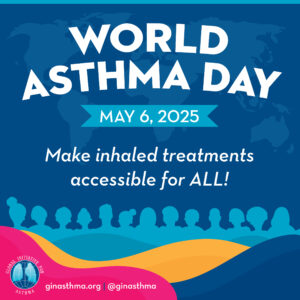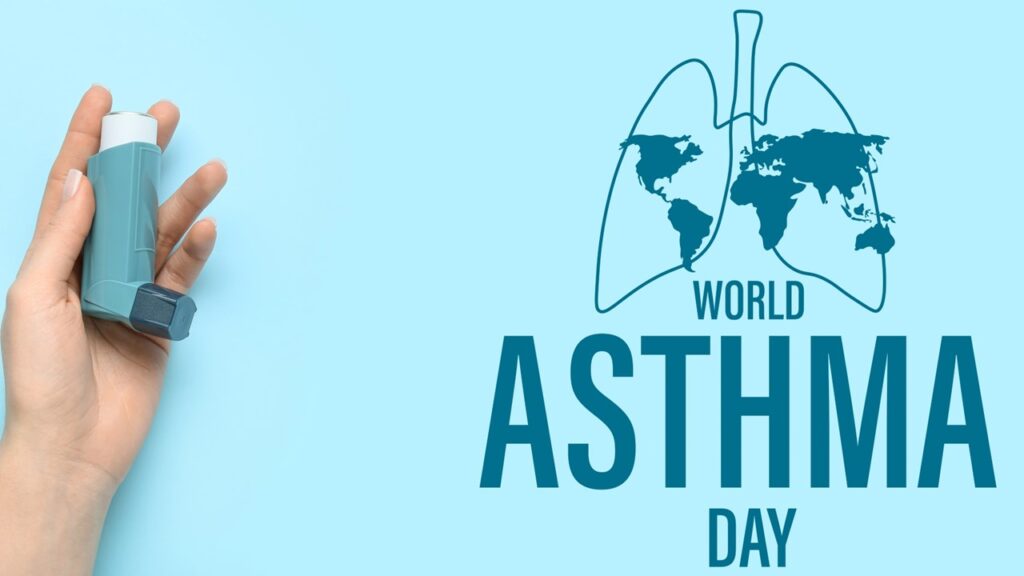May 6 is World Asthma Day, a global event dedicated to raising awareness about asthma, improving care and advocating for better outcomes for the millions affected by the chronic respiratory disease.
Organized annually by the Global Initiative for Asthma (GINA), World Asthma Day serves as a rallying point for patients, caregivers, healthcare professionals, policymakers and advocates.

Global Initiative for Asthma (GINA) every year.
To mark World Asthma Day 2025, GINA has selected the theme “Make Inhaled Treatments Accessible for ALL.”
The theme highlights the urgent need to ensure that everyone with asthma has access to inhaled medications, which are critical for both managing the disease and treating acute attacks.
The day serves as a reminder of the importance of education, prevention and effective management in improving the lives of those with asthma.
Asthma Statistics
Asthma affects over 260 million people worldwide and about 25 million people in the US.
Asthma attacks can cause significant distress for both patients and their caregivers, often leading to hospitalizations and, in severe cases, death.
Asthma leads to more than 450,000 deaths worldwide each year — most of which are preventable, according to GINA.
Its burden continues to grow, particularly in low- and middle-income countries.
Asthma remains a significant public health challenge in the US. More than 26 million Americans, including 4.5 million children, live with the condition.
The economic burden of asthma is staggering, even in developed countries like the US where costs reach $80 billion each year when accounting for medical costs, missed school and workdays and premature deaths.
Asthma also disproportionately impacts low-income and minority communities in the US, underscoring the urgent need for targeted resources and interventions to close these gaps.
Despite effective treatments, many people still struggle with uncontrolled symptoms, preventable hospital visits and premature deaths.
World Asthma Day 2025: The Role of the Environment, Indoor and Outdoor
Environmental triggers play a major role in asthma exacerbations.
Common indoor triggers include dust mites, mold, pet dander and cockroach droppings. Outdoor triggers such as ozone, particulate matter and wildfire smoke can also worsen symptoms.
Chemical irritants like tobacco smoke, strong odors and certain cleaning agents are additional culprits.
Managing these triggers involves practical steps like regular home cleaning to reduce dust and mold, monitoring local air quality through tools like AirNow.gov and working with healthcare providers to develop personalized asthma action plans.
To support asthma awareness and better management, the US Environmental Protection Agency (EPA) offers resources, including the Asthma Awareness Month Toolkit and infographics on common asthma triggers. It also offers access to the Asthma Community Network, where programs across the country can share best practices and insights.
By using these educational tools, individuals, families and organizations can help reduce the burden of asthma in their communities.
Call to Improve Access to Life-Saving Asthma Inhalers
Inhaled corticosteroid medications help prevent asthma attacks by targeting the underlying inflammation that drives asthma.
A staggering 96% of global asthma deaths occur in low- and middle-income countries. This is due to limited access and the high cost of inhaled medications — particularly inhaled corticosteroid inhalers.
Even in high-income countries, the high cost of inhaled medications limits access for many people with asthma, leading to poor disease control and preventable deaths.
GINA is calling on doctors and allied healthcare professionals to ensure that every asthma patient is prescribed evidence-based, essential inhaled corticosteroid medications — either alone or alongside reliever treatments — to help prevent the ongoing, avoidable illness and deaths caused by asthma.
The organization is also urging policymakers, governments, payers and pharmaceutical companies to recognize the ongoing, avoidable burden of asthma and take action to improve access to proven, effective treatments.
GINA Reports page provides access to GINA’s key resources, including annual reports, global strategy documents, pocket guides and educational materials.
The reports cover evidence-based asthma management strategies, updated treatment recommendations, clinical tools and guidance for healthcare professionals.
The page is intended for clinicians, researchers, policymakers and patient advocates seeking up-to-date resources to improve asthma care and outcomes worldwide.
Asthma Drug Outlook: Market Leaders to Promising Candidates
In addition to inhalers, several major pharma players lead with both current therapies and promising pipeline drugs for the treatment of asthma.
Sanofi and Regeneron continue to dominate the asthma drug market with their blockbuster biologic Dupixent (dupilumab). In 2024, the drug netted global sales of approximately €13 billion ($14.15 billion). The dual IL-4/IL-13-targeting monoclonal antibody was approved in 2018 for moderate-to-severe asthma.
GSK also remains a top player with Nucala (mepolizumab) and Fasenra (benralizumab), both anti-IL-5 therapies designed for eosinophilic asthma. The company also offers Trelegy Ellipta (fluticasone furoate/umeclidinium/vilanterol), a once-daily triple combination inhaler.
Nucala generated approximately £1.78 billion ($2.3 billion) in global sales, marking a 12% increase from the previous year, accounting for about 6% of GSK’s total revenue. Fasenra recorded sales of $1.55 billion in 2024, reflecting an 11% increase over the previous year.
Meanwhile, AstraZeneca and Amgen’s jointly developed Tezspire (tezepelumab), approved in 2021 as the first agent to block TSLP, an upstream regulator of airway inflammation, hit $1.22 billion in sales in 2024, a significant increase from $653 million in 2023.
Looking ahead, companies are investing heavily in next-generation asthma treatments. Amgen and AstraZeneca are expanding Tezspire into new indications, including chronic rhinosinusitis with nasal polyps (CRSwNP) and COPD.
Sanofi and Regeneron are advancing their respiratory pipeline with amlitelimab, which has shown promising results in Phase II studies for moderate-to-severe asthma. Additionally, the duo’s IL-33 inhibitor itepekimab is being evaluated for its efficacy in asthma and other respiratory conditions.
Additionally, Regeneron is investigating R256, an inhaled JAK inhibitor in early development, which could offer a novel oral or inhaled alternative to biologic therapies.
And iTeos Therapeutics is developing anti-TIGIT antibody EOS-448 in partnership with GSK.
GSK is also developing GSK3511294 (depemokimab), an ultra-long-acting anti-IL-5 therapy intended for dosing as infrequently as every six months.
Depemokimab is under FDA review for the treatment of asthma with type 2 inflammation, characterized by an eosinophilic phenotype. It has also been submitted for CRSwNP.
If approved, it would be the first ultra-long-acting biologic with a six-month dosing schedule for severe asthma, offering a more convenient treatment option for patients and potentially improving adherence to therapy.
If you want to have your organization featured on Xtalks, please email Ayesha Rashid at: [email protected]












Join or login to leave a comment
JOIN LOGIN